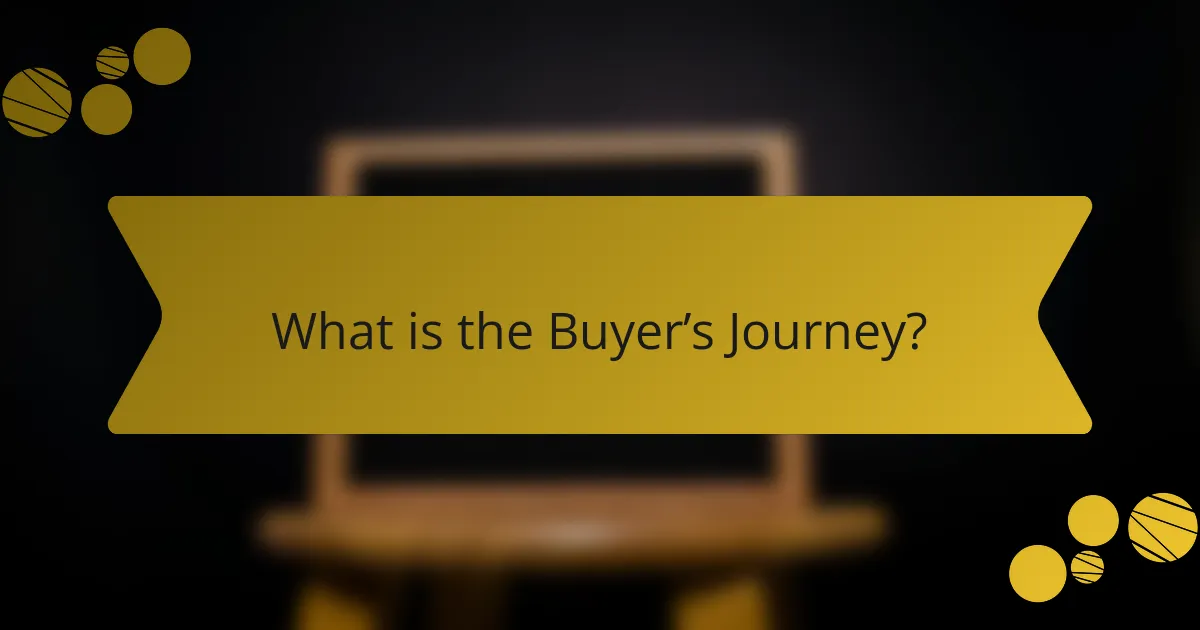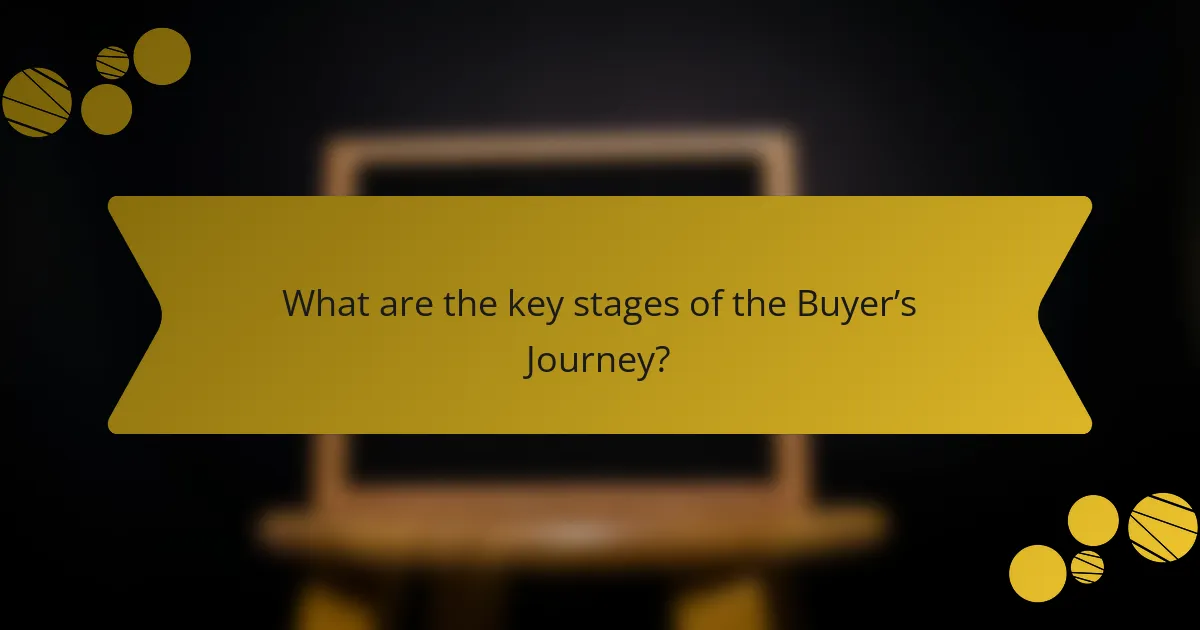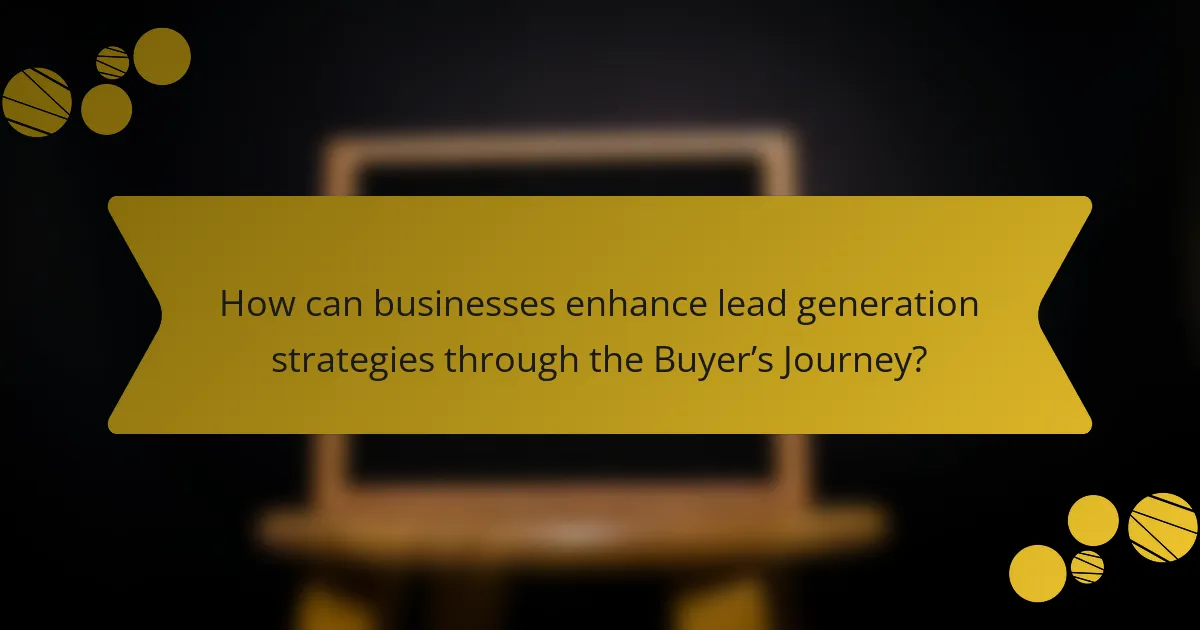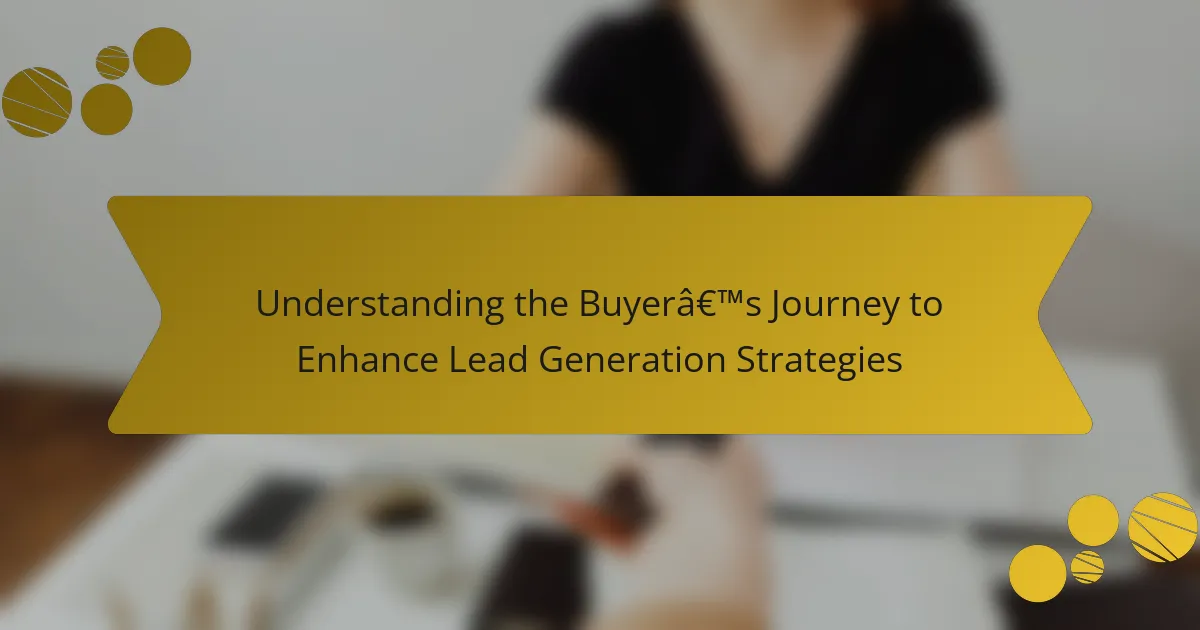The Buyer’s Journey is a structured process that potential customers undergo when making purchasing decisions, encompassing three key stages: awareness, consideration, and decision. In the awareness stage, buyers identify their needs and seek information to understand their options. The consideration stage involves evaluating various solutions and comparing products or services based on features and benefits. Finally, in the decision stage, buyers select a specific solution and finalize their purchase. This article explores how businesses can enhance their lead generation strategies by aligning their marketing efforts with each stage of the Buyer’s Journey, providing targeted content that meets the needs of potential customers at every step.

What is the Buyer’s Journey?
The Buyer’s Journey is the process that potential customers go through when making a purchase decision. It typically consists of three stages: awareness, consideration, and decision. In the awareness stage, buyers identify a problem or need. They seek information to understand their options. During the consideration stage, they evaluate different solutions. Buyers compare products and services based on features and benefits. In the decision stage, they choose a specific solution. They finalize their purchase and may seek reassurance about their choice. This journey is crucial for marketers to tailor their strategies effectively. Understanding each stage helps in creating targeted content. This ultimately enhances lead generation efforts.
How does the Buyer’s Journey influence lead generation?
The Buyer’s Journey significantly influences lead generation by shaping how potential customers interact with content. This journey consists of three stages: awareness, consideration, and decision. In the awareness stage, buyers recognize a problem or need. Effective lead generation strategies provide informative content that addresses these issues. In the consideration stage, buyers evaluate different solutions. Here, lead generation focuses on offering comparative content and detailed insights. In the decision stage, buyers are ready to make a purchase. Lead generation efforts must include clear calls-to-action and compelling offers. Research shows that 70% of the buyer’s journey occurs before a buyer contacts a sales representative. This highlights the importance of aligning lead generation tactics with each stage of the Buyer’s Journey.
What are the stages of the Buyer’s Journey?
The stages of the Buyer’s Journey are Awareness, Consideration, and Decision. In the Awareness stage, potential buyers identify a problem or opportunity. They seek information to understand their needs better. In the Consideration stage, buyers evaluate different solutions. They compare options and analyze the benefits of each. Finally, in the Decision stage, buyers choose a solution and make a purchase. Research shows that understanding these stages helps marketers tailor their strategies effectively. This approach increases engagement and conversion rates.
How do buyer personas fit into the Buyer’s Journey?
Buyer personas are essential in the Buyer’s Journey as they represent the target audience’s characteristics and behaviors. They help marketers understand the needs and motivations of potential customers. This understanding allows for tailored content that addresses specific pain points at each stage of the journey. For example, during the awareness stage, content can focus on educational resources that resonate with the persona’s challenges. In the consideration stage, comparisons and detailed information can guide decision-making. Finally, in the decision stage, testimonials and case studies can reinforce trust. Research shows that 70% of companies that use buyer personas effectively report improved engagement and conversion rates.
Why is understanding the Buyer’s Journey important for businesses?
Understanding the Buyer’s Journey is crucial for businesses because it enables them to tailor their marketing strategies effectively. The Buyer’s Journey consists of three stages: awareness, consideration, and decision. Each stage represents a different phase in the customer’s decision-making process. By comprehending these stages, businesses can create targeted content that addresses specific customer needs. For instance, 70% of buyers conduct research online before making a purchase decision. This statistic highlights the importance of providing relevant information at the awareness stage. Additionally, businesses that align their strategies with the Buyer’s Journey can improve lead conversion rates by 50%. Understanding this journey ultimately leads to better customer engagement and higher sales.
What impact does the Buyer’s Journey have on marketing strategies?
The Buyer’s Journey significantly influences marketing strategies. It outlines the stages a customer goes through before making a purchase. Understanding these stages allows marketers to tailor their content and messaging. Marketers can create targeted campaigns for awareness, consideration, and decision phases. This alignment improves engagement and conversion rates. Research shows that 70% of the buyer’s journey is done digitally. Effective strategies address customer needs at each stage. This leads to higher customer satisfaction and loyalty.
How does the Buyer’s Journey affect customer retention?
The Buyer’s Journey significantly influences customer retention by shaping the overall customer experience. During the journey, customers progress through stages: awareness, consideration, and decision. Each stage presents opportunities to engage customers effectively. Tailored communication during these stages fosters trust and satisfaction. Satisfied customers are more likely to return, leading to higher retention rates. According to HubSpot, companies that excel at customer experience retain 89% of their customers. This statistic highlights the direct correlation between a well-managed Buyer’s Journey and customer loyalty.

What are the key stages of the Buyer’s Journey?
The key stages of the Buyer’s Journey are Awareness, Consideration, and Decision. In the Awareness stage, potential buyers recognize a problem or need. They seek information to understand their situation better. In the Consideration stage, they evaluate different solutions and options. Buyers compare various products or services available in the market. Finally, in the Decision stage, they make a choice and purchase a product or service. This structured approach helps marketers tailor their strategies to meet buyers’ needs effectively.
What happens during the awareness stage?
During the awareness stage, potential customers recognize a problem or need. They begin to seek information to understand their situation better. This stage involves gathering data to explore possible solutions. Buyers may engage with educational content like blogs, videos, or infographics. They are not yet ready to make a purchase decision. Instead, they focus on learning and identifying options. Research shows that 70% of buyers prefer to learn about a company through articles rather than ads. This indicates the importance of providing valuable content during this phase.
How can businesses effectively engage leads in the awareness stage?
Businesses can effectively engage leads in the awareness stage by providing valuable content that addresses their needs. This content can include blog posts, infographics, and videos that educate potential customers. By offering insights into common problems, businesses can attract attention and establish authority. Engaging leads through social media platforms also enhances visibility and interaction. Research shows that 70% of consumers prefer learning about a company through articles rather than ads. Utilizing SEO strategies helps ensure this content reaches the right audience. Email newsletters can further nurture leads by delivering relevant information directly to their inbox. By focusing on informative and engaging content, businesses can foster relationships with leads in the awareness stage.
What content types are most effective for the awareness stage?
Blog posts are the most effective content type for the awareness stage. They provide valuable information that addresses potential customers’ questions. Blog posts can improve search engine visibility, attracting organic traffic. Infographics are also effective as they present complex information visually. They can quickly communicate key messages and engage users. Social media posts help raise awareness through shares and interactions. These posts can create conversations around a brand or product. Videos can capture attention and convey messages succinctly. They are highly shareable and can enhance engagement. E-books and guides can provide in-depth knowledge, establishing authority. They are often used as lead magnets to gather contact information. Each of these content types plays a crucial role in creating awareness and attracting potential leads.
What occurs in the consideration stage?
In the consideration stage, potential buyers evaluate different solutions to their identified problems. They compare various options and weigh the benefits and drawbacks of each. This stage involves gathering information about products or services that meet their needs. Buyers often seek reviews, case studies, and product comparisons during this phase. They may engage with content such as webinars or detailed guides. The goal is to narrow down choices and identify the best fit. Understanding this behavior helps marketers tailor their strategies to provide relevant information. This targeted approach increases the likelihood of conversion as buyers move toward the decision stage.
How should businesses tailor their messaging during the consideration stage?
Businesses should tailor their messaging during the consideration stage by providing detailed information that addresses potential customer needs. This includes highlighting product benefits, features, and comparisons with competitors. Clear, concise content helps customers evaluate options effectively. Utilizing case studies and testimonials can build trust and credibility. Engaging visuals and informative content can enhance understanding. According to a HubSpot report, 61% of consumers prefer brands that provide custom content. This shows the importance of personalization in messaging. Tailored communication can significantly influence decision-making during this stage.
What tools can assist in nurturing leads during this stage?
Email marketing platforms are effective tools for nurturing leads. They allow businesses to send personalized content directly to potential customers. Platforms like Mailchimp and HubSpot facilitate automated email campaigns. These campaigns can target specific segments based on user behavior. CRM systems such as Salesforce help track interactions with leads. They provide insights into lead preferences and engagement history. Content marketing tools like Buffer enable sharing valuable content consistently. This keeps leads engaged and informed throughout their journey. Webinars and online events foster direct interaction, enhancing trust and rapport. These tools collectively support lead nurturing by maintaining communication and providing relevant information.
What is involved in the decision stage?
The decision stage involves evaluating options and making a final choice. At this point, buyers analyze available solutions. They compare features, benefits, and pricing. Buyers also consider customer reviews and testimonials. This stage often includes consultations or demos. The goal is to select the best solution for their needs. Research shows that 70% of buyers prefer to review multiple options before deciding. This thorough evaluation ensures that buyers feel confident in their choice.
How can businesses optimize their offers for the decision stage?
Businesses can optimize their offers for the decision stage by providing clear value propositions and competitive comparisons. They should highlight unique selling points that differentiate their products or services. Offering testimonials and case studies can build trust and credibility. Additionally, providing limited-time promotions can create urgency. Clear calls to action should guide potential customers toward making a decision. Research shows that 70% of consumers are influenced by reviews before purchasing. By leveraging these strategies, businesses can effectively align their offers with customer needs during the decision stage.
What role does customer feedback play in the decision stage?
Customer feedback plays a critical role in the decision stage of the buyer’s journey. It helps potential customers evaluate their options and influences their final purchasing decision. Positive feedback can enhance trust in a product or service. Negative feedback can highlight areas for improvement or deter potential buyers. Research shows that 79% of consumers trust online reviews as much as personal recommendations. This statistic underscores the importance of customer feedback in shaping perceptions. Additionally, feedback can guide businesses in refining their offerings to better meet customer needs. Ultimately, customer feedback serves as a valuable resource for both consumers and businesses during the decision-making process.

How can businesses enhance lead generation strategies through the Buyer’s Journey?
Businesses can enhance lead generation strategies by aligning their marketing efforts with the Buyer’s Journey stages. The Buyer’s Journey consists of three stages: awareness, consideration, and decision. In the awareness stage, businesses should provide informative content that addresses potential customers’ pain points. This could include blog posts, infographics, or videos that educate prospects. In the consideration stage, businesses can offer case studies, webinars, and comparison guides to help prospects evaluate their options. Providing detailed information builds trust and positions the business as a knowledgeable resource. Finally, in the decision stage, businesses should present clear calls to action, customer testimonials, and product demos. Research shows that 70% of buyers prefer to learn about a company through articles rather than ads. By tailoring content to each stage of the Buyer’s Journey, businesses can effectively guide prospects toward becoming leads and ultimately customers.
What are effective lead generation tactics aligned with the Buyer’s Journey?
Effective lead generation tactics aligned with the Buyer’s Journey include content marketing, targeted advertising, and email campaigns. Content marketing provides valuable information that addresses potential customers’ needs at each stage. For instance, blog posts and ebooks can assist in the awareness stage. Targeted advertising can reach specific demographics based on their online behavior. This method ensures that the right message reaches the right audience at the right time. Email campaigns nurture leads by delivering personalized content that aligns with their interests. Research indicates that segmented email campaigns can achieve 14.31% higher open rates. Utilizing social media to engage with prospects also enhances brand visibility and fosters relationships. These tactics, when strategically implemented, effectively guide leads through the Buyer’s Journey.
How can content marketing support lead generation throughout the Buyer’s Journey?
Content marketing supports lead generation throughout the Buyer’s Journey by providing valuable information tailored to each stage. At the awareness stage, informative blog posts and videos attract potential customers. These resources help them recognize their problems and consider solutions. In the consideration stage, case studies and comparison guides offer deeper insights into available options. This content assists prospects in evaluating different solutions. During the decision stage, product demos and testimonials build trust and confidence. They encourage prospects to make informed purchasing decisions. According to HubSpot, companies that prioritize content marketing see conversion rates six times higher than those that do not. This illustrates the effectiveness of content marketing in generating leads at every stage of the Buyer’s Journey.
What metrics should businesses track to measure success?
Businesses should track key performance indicators (KPIs) to measure success. Important metrics include conversion rate, which indicates the percentage of leads that become customers. Customer acquisition cost (CAC) measures the cost to acquire a new customer. Customer lifetime value (CLV) assesses the total revenue a customer generates over their relationship with the business.
Additionally, return on investment (ROI) evaluates the profitability of marketing efforts. Net promoter score (NPS) gauges customer satisfaction and loyalty. Churn rate reflects the percentage of customers lost over a specific period. Tracking these metrics provides actionable insights for improving lead generation strategies and overall business performance.
How can businesses analyze data to improve their lead generation strategies?
Businesses can analyze data to improve their lead generation strategies by leveraging analytics tools and customer insights. They can track user behavior on their websites to identify patterns and preferences. Analyzing demographic data helps businesses understand their target audience better. Utilizing CRM systems allows businesses to segment leads based on their interactions. This segmentation improves targeting and personalization of marketing efforts. Additionally, A/B testing different lead generation tactics provides data on what resonates with potential customers. The use of predictive analytics can forecast future lead behavior based on historical data. According to a report by HubSpot, companies that prioritize data-driven marketing are 6 times more likely to be profitable year over year.
What are best practices for implementing Buyer’s Journey insights into lead generation?
To implement Buyer’s Journey insights into lead generation effectively, businesses should align their content with each stage of the journey. This involves creating targeted content for awareness, consideration, and decision stages. For example, educational blog posts can attract potential leads in the awareness stage. In the consideration stage, detailed product comparisons can help nurture leads. Finally, case studies or testimonials can facilitate decision-making.
Additionally, mapping customer pain points to content solutions is crucial. This ensures that the content addresses specific needs at each stage. Utilizing data analytics to track engagement and conversion rates can provide insights into content effectiveness. Regularly updating and optimizing content based on feedback and performance metrics enhances lead generation efforts. Studies indicate that companies using Buyer’s Journey insights see a 50% increase in qualified leads.
How can businesses continuously refine their understanding of the Buyer’s Journey?
Businesses can continuously refine their understanding of the Buyer’s Journey by utilizing data analytics and customer feedback. Analyzing customer interactions across various touchpoints provides insights into their behaviors and preferences. Regularly updating buyer personas based on this data helps align marketing strategies with customer needs. Conducting surveys and interviews allows businesses to gather qualitative insights directly from customers.
Implementing A/B testing on marketing messages can reveal which approaches resonate best with target audiences. Tracking key performance indicators (KPIs) such as conversion rates and engagement levels informs businesses about the effectiveness of their strategies. Utilizing CRM systems aids in monitoring customer interactions and identifying trends over time.
Research shows that companies using data-driven strategies achieve 5-6 times higher conversion rates. This evidence supports the claim that continuous refinement through data analysis and customer engagement leads to a deeper understanding of the Buyer’s Journey.
What common pitfalls should businesses avoid when utilizing the Buyer’s Journey in lead generation?
Businesses should avoid several common pitfalls when utilizing the Buyer’s Journey in lead generation. One major pitfall is failing to understand the stages of the Buyer’s Journey. Each stage—awareness, consideration, and decision—requires tailored content and messaging. Another pitfall is neglecting to segment the audience effectively. Not all leads are at the same stage, and generic messaging can lead to disengagement.
Additionally, businesses often overlook the importance of nurturing leads throughout the journey. Without consistent engagement, potential customers may lose interest. Another mistake is relying solely on quantitative metrics. Qualitative insights are crucial for understanding customer motivations and challenges.
Finally, some businesses fail to align sales and marketing teams. Misalignment can disrupt the flow of leads and hinder conversion rates. In summary, understanding the Buyer’s Journey and avoiding these pitfalls can significantly enhance lead generation efforts.
The main entity of the article is the Buyer’s Journey, which outlines the stages potential customers navigate when making a purchase decision: awareness, consideration, and decision. The article emphasizes the significance of understanding these stages to enhance lead generation strategies. It discusses how tailored content can effectively engage customers at each stage, leveraging buyer personas for targeted messaging and highlighting the impact of customer feedback on decision-making. Additionally, it addresses best practices for aligning marketing efforts with the Buyer’s Journey to improve conversion rates and overall business performance.
